Stretch Yourself
Difficulties with Doing a Side Split
by Thomas
Kurtz, author of Stretching Scientifically and Secrets
of Stretching
This is the second installment of my column on training that appeared
in May 1999 issue of TaeKwonDo Times.
Read the previous installment here.
In the first article of this column (in TaeKwonDo Times March
1999) you have learned how to determine if you have the potential to do
a side split, even before you start your stretching program. You have
also learned that for many adults, who can perform the side split test,
side or straddle splits are still very difficult. At a certain point,
well before sliding into a full split, they feel that there is a “stop,”
accompanied by pain in the outside hip or upper thigh region that prevents
them from sitting in a full side split. In this article you will learn
what causes it and what to do about it.
The problem does not seem to be related to the adductors (inner thigh
muscles), as they do not feel much tension there. As they continue stretching,
their flexibility does improve, but at a very slow rate.
This perceived barrier is a very common problem for people who start
stretching as adults. The pain and limitation of the movement sideways
in the side (straddle) split is caused by spreading (abducting) the thighs
without tilting the pelvis forward. This tilt unwinds capsular ligaments
of the hip, among them the pubofemoral ligament that in a normal, non-flexed
position would resist excessive abduction and would also, during straight
abduction, push up the neck of the femur (thigh bone) into the cartilage
collar (labrum acetabulare) at the upper edge of the hip socket. For persons
in whom the angle between the neck and shaft of the femur is less than
135°, abduction without tilting the pelvis jams the greater trochanter
(a bony process on the top of the femur) against the hipbone.
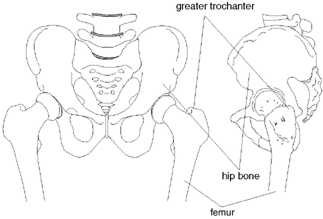
The forward tilt of the pelvis (hip flexion) realigns the hip joint so
its ligaments relax, the neck of the femur does not jam the cartilage
at the upper edge of the socket, and the greater trochanter fits into
a space behind the hip socket. This is the alignment of your hips in the
proper horse-riding stance and this is why alignment of your hips, thighs,
lower legs, and feet in a side split should be the same.
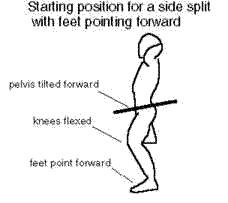
Starting position for a side split.
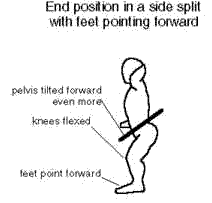
Getting into a side split:
legs are spread sideways and pelvis is tilted forward.
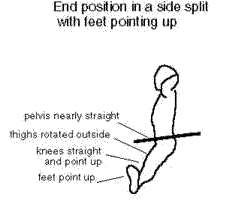
Side split with feet pointing up.
The hips are straight thanks to the rotation of the thighs.
Note that in doing a side split with toes pointing forward you not only
spread the legs sideways, but also tilt the pelvis forward. In a side
split with the feet pointing up, you keep your pelvis straight but rotate
the thighs outward. The alignment of the hips and thighs in both types
of the side splits is the same.
Another way of finding the correct alignment is to use the horse-riding
stance as the initial position for your isometric stretches leading to
the side split. Just make sure that your stance is perfect, with your
thighs parallel to the floor at any width, toes pointing forward, and
chest up.
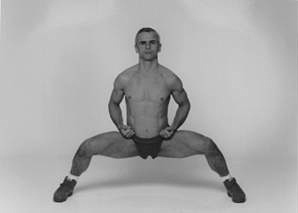
Front view of a “five-step” horse stance
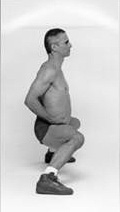
Side view of a “five-step” horse stance
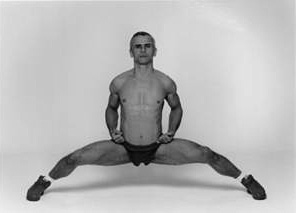
Front view of a “seven-step” horse stance
To sum it all up, you cannot do the side split without either rotating
your thighs outward or tilting the pelvis forward. The outward rotation
or the forward tilt (hip flexion) unwinds capsular ligaments of the hip,
among them the pubofemoral ligament, which resists excessive abduction.
Spreading the legs without these additional movements twists and tightens
the ligaments of the hip and pushes up the neck of the femur into the
cartilage collar at the upper edge of the hip socket. For persons who
have coxa vara (less than 135° angle between the neck and shaft of the
femur), abducting the thigh without tilting the pelvis jams the greater
trochanter against the hipbone above the acetabulum (hip joint cavity).
This jamming of either the neck of the femur into the cartilage or of
greater trochanters against hip bones is the cause of pain and of a limit
to the sideways movement in both the side split and the raising side kick.
If the outside of your hips hurts when you do high side kicks you need
to learn how to tilt your pelvis while you kick. The same forward tilt
of the pelvis that helps to do a side split will let you raise your leg
higher to the side because the reason for the pain and limitation in the
sideways movement in both side kicks and in the side split is the same.
In the next issue you will learn how to test if your joints and muscles
of your thighs and hips will permit you to do a front split.
|